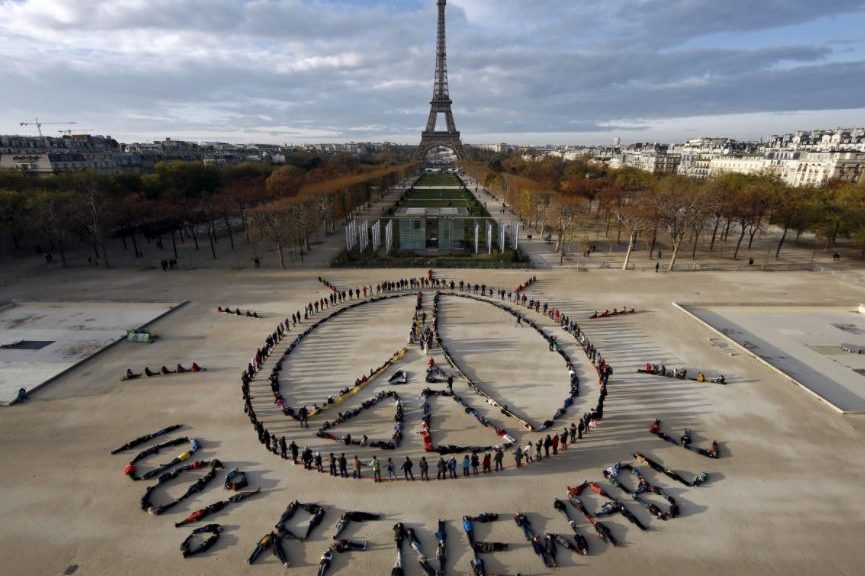
After Paris
As you’ve no doubt heard by now, last week our fearless leader announced that the United States will no longer commit itself to joining with pretty much every other country in the world to make sure that the planet maybe stays a little bit inhabitable. On the bright side: North Korea did sign it, so we’re not in bed with those crazies! On the less bright side: Nicaragua and Syria are the only two other countries who aren’t participating. Not sure we want to be like them.
One line from his speech has been getting a lot of play in the press. Midway through his pronouncement, he declared that he was elected to represent the residents of Pittsburgh, not of Paris. Leaving to one side that Clinton actually carried 75% of the vote in Pittsburgh, the response from the city has been an interesting illustration of where cities today stand on climate issues. Pittsburgh itself also is an interesting case study of how cities can reinvent themselves and actually profit from a transition to a cleaner economy. The city is, of course, known for its industrial history, but the images of smog and factories and steel mills that come to mind are hardly relevant today. Today’s Pittsburgh, for instance, is home to Uber’s self-driving technology, to wildly innovative new medical research, and to advances in clean energy. If Trump really cared about representing the “people of Pittsburgh”, he would in fact have stayed in the Paris Agreement – that’s what the residents have been building at home. The mayors of Pittsburgh and Paris even teamed up to pen an Op-Ed about how their interests are closely aligned.
An interesting piece of the response last week’s announcement has been the response of mayors around the country. Mayors, even more than governors, have vowed that their political regions will continue to press on in the fight for cleaner lifestyles for their citizens. The project has been spearheaded by Mike Bloomberg, ex-mayor of New York City, but includes more than 30 mayors and 3 governors so far. For the past decade, we’ve been thinking of the fight against climate change as something requiring international coordination because of how difficult a problem it is. We’re now seeing a big shift to the local level. Municipalities, it seems, will be on the front lines of the fight moving forward.
Why is that?
Putting the ideological leanings of cities to one side, there are a couple of big, overarching reasons behind this movement. The first is simply the fact that cities are responsible for the lion’s share of greenhouse gas emissions. In fact, despite covering only about 2% of the world’s land mass and housing about 50% of global population, cities are responsible for nearly 70% of all emissions. Mayors around the globe are seeing that strong leadership in a relatively small number of political jurisdictions will actually have a big impact. By targeting urbanized areas, we can take large strides toward reducing emissions.
A second big factor is the disparity in the carbon footprints of metropolitan areas in the United States and elsewhere. I came across a zip-code-level map of carbon emissions last week and have been having fun exploring different areas on it. Here’s a map of the whole US. Green areas have low carbon footprints while red areas have high ones:

“Whoa!”, you’re saying. “I though cities had way lower environmental impacts than rural areas! What’s going on?” The red areas here are concentrated around the largest cities, particularly in the Northeast Corridor running from DC to Boston.
When we zoom in, though, a different pattern reveals itself.
Here’s the NYC area:
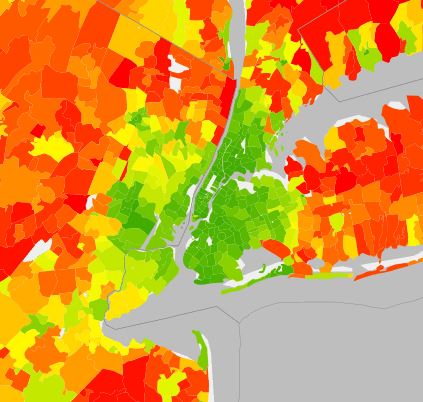
Boston:
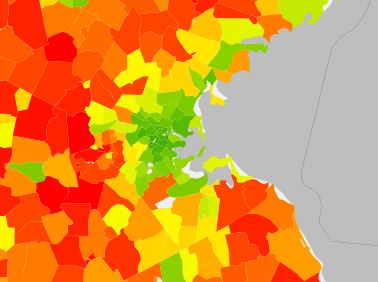
Chicago:
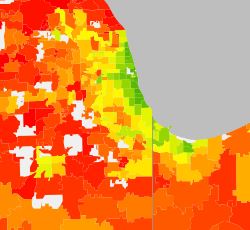
Dallas:
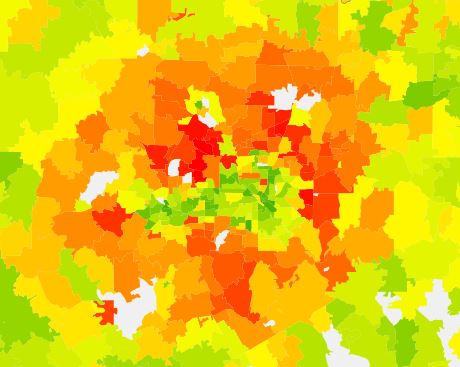
Portland, Oregon:
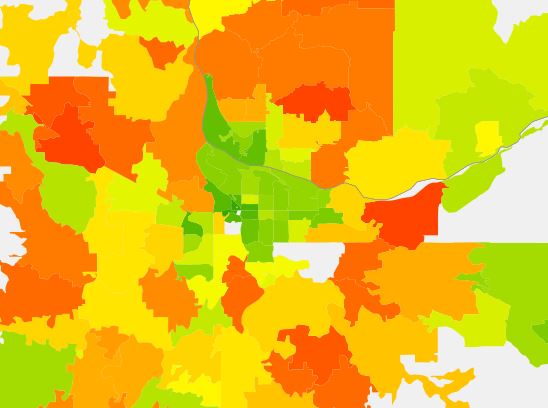
And Los Angeles:
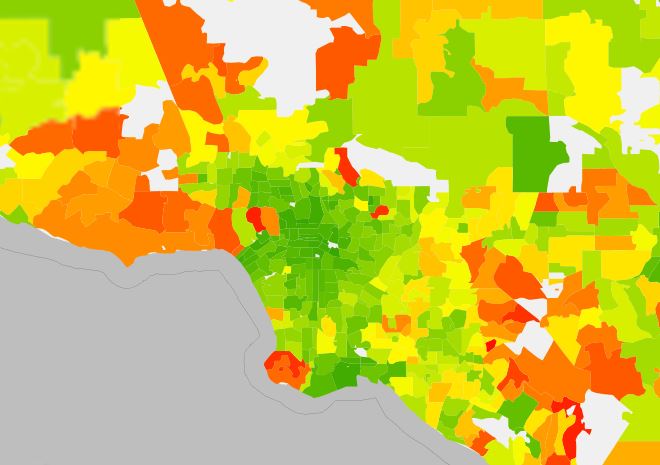
What we ACTUALLY see is that the areas ringing these cities have huge carbon footprints, while residents of the city centers have significantly lower impacts. The pattern is obviously strong in the first three, older cities with extensive public transit networks, but the pattern holds for Dallas, Portland, and Los Angeles which each have higher numbers of drivers.
This phenomenon has two main drivers. Firstly, and most obviously, residents of denser areas don’t have to drive as much. They tend to live closer to work, closer to the grocery store, and closer to entertainment, which means that even when they do have to drive somewhere, they take shorter trips. Conversely, suburbanites drive far more than residents of either the city or rural areas – and they spend much of that driving distance in emission-spewing traffic.
The second factor is home size. Homes in dense, urban areas tend to be much smaller than those in the outlying suburbs. Heating homes and providing electricity is a dirty business, and the higher a home, the higher its emission rate. Smaller homes in the city, and particularly townhouses and brownstones with shared walls, are vastly more efficient to heat, resulting in lower emissions.
So cities can provide a platform, then, for some of the highest and some of the lowest polluting lifestyles in the country. What does that mean for urban policy? And why does that mean mayors are leading the charge?
As I wrote about last week, regional governance in the United States in abysmal. For the most part, suburban municipalities and central cities are in competition with one another, with suburban areas trying to get as many of the benefits while shouldering as few of the costs of the anchor city as possible. However, when it comes to greenhouse emissions, and emissions from transportation in particular, regional planning is in fact possible because the interests of cities and suburbs are broadly in line with one another – if only we can figure out how to pay for them. If you look at a city like Boston or New York or Washington, D.C., it quickly becomes clear that a large chunk of the people in cars aren’t actually residents; often, they’re folks who live in the suburbs who are driving into the central city for work, for doctor’s appointments, for dinner, for whatever. These drivers (and resident drivers, too) impose big costs. From slower response times for emergency vehicles to noxious fumes, from pedestrian safety to delayed deliveries for local businesses, cities suffer from suburbanites driving into the city. Similarly, these drivers aren’t pleased with conditions: my boss’ wife, for instance, spend 3.5 hours going the 1.4 miles between the Manhattan Bridge and the Holland Tunnel last week (no, that’s not a typo – that’s an average speed of 0.4 MPH, with three kids under 5 in tow).
The reality for most people in the country is enforced auto dependence. Much of the development that has occurred in the United States for the last eight decades was built on the availability of affordable cars and cheap gas. Growing up even in Portland, I rode the MAX train only a handful of times a year – and I’d never once stepped foot on a public bus until I moved to Boston at age 18. Moving these outlying, sprawling areas away from car dependence and toward less-polluting means of transportation will take generations, even if people do start realizing and responding to how harmful cars are for the environment.
For those who commute into the city for work or for play, however, there are enormous benefits to commuter rail and express buses. Not only are riders more productive because they can work/read/eat/nap/anything else, it also tends to cost less than car ownership and parking. Cities benefit, too, as fewer of these commuters drive into the city, clogging streets and demanding public space to leave their cars all day. Trump has talked a lot about massive investment in infrastructure to jump start the economy. Historically, we’ve used stimulus money of this sort to build bridges and roads. We can, however, find ways to spend this money on commuter rail and other transportation systems that are way more efficient and way greener than car infrastructure – and it would even raise the quality of life for people in cites and in suburbs.
Luckily for us here in New York, our mayor and governor are developing innovative ways to help get people out of cars to reduce wasted time, wasted space, and needless emissions. The governor knows that as he gears up to run for the Democratic nomination in 2020 as The Country’s Christened Progressive, he should be supporting mass transit in the country’s biggest, densest city.
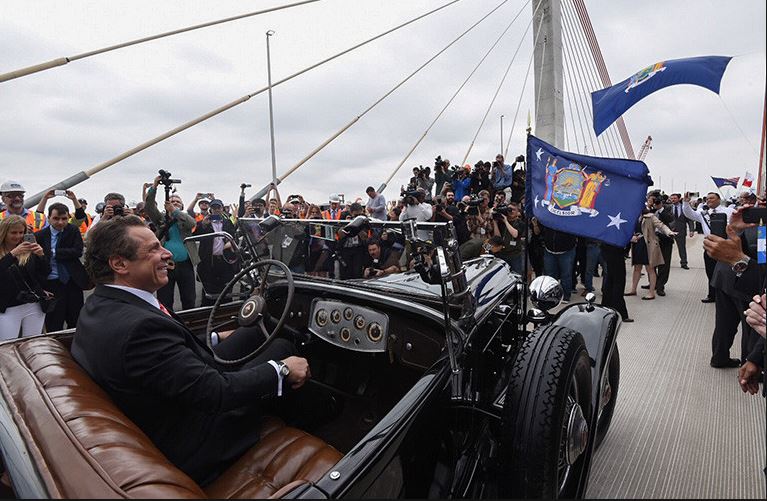
Oh wait haha I forgot. Our governor is actually running as fast as he can from a mass transit system that’s falling apart on his watch. At least our mayor, though, understands that our transit system keeps the city green, right? And is fighting for things like congestion pricing to reduce the number of cars coming into Manhattan?
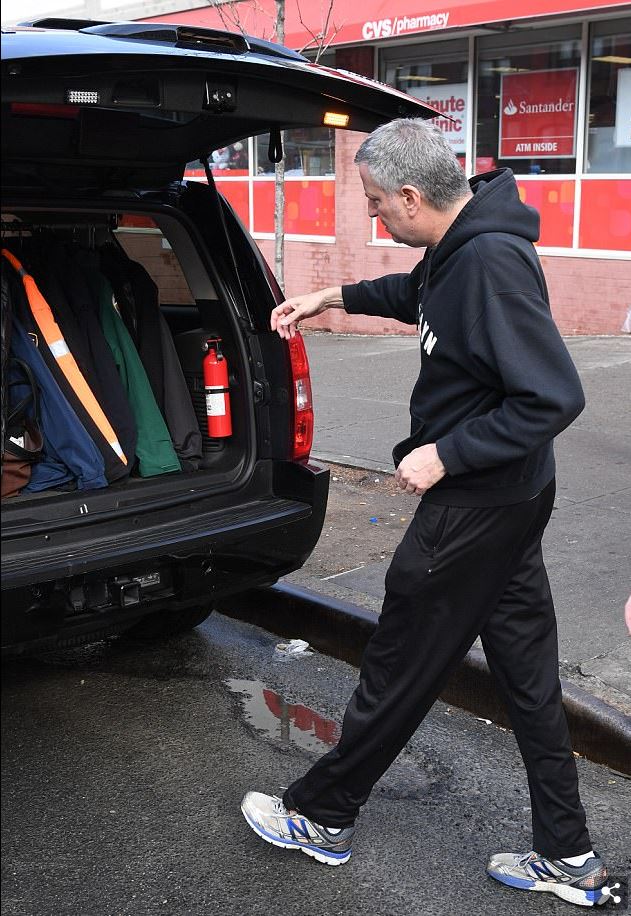
What? You’re saying he drives 11 miles a day through Manhattan and Brooklyn, with an SUV escort, because he likes that particular YMCA? And he hasn’t been on a subway since the middle of April, despite the fact that 57% of his constituents commute every day by transit?
At least they lit up the Freedom Tower and City Hall in green to mourn either the US leaving the Paris Agreement or their own egregious unwillingness to invest in assets that actually reduce carbon emissions:
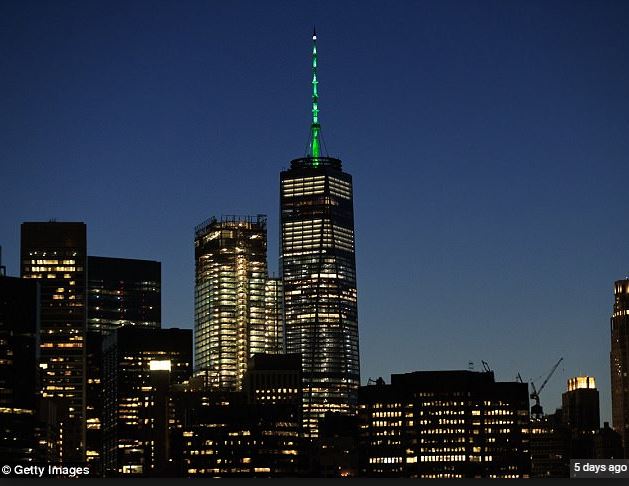

God help us.